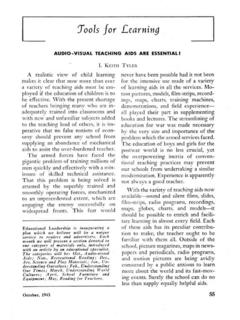Transcription of Success Factors - who.int
1 Success Factors for Women s and Children s HealthCambodiaMinistry of Health, Cambodia2 Suggested citation: Ministry of Health Cambodia, PMNCH, WHO, World Bank, AHPSR and participants in the Cambodia multistakeholder policy review (2014). Success Factors for Women s and Children s Health: Cambodia. Success Factors for women s and children s health: Cambodia is a document of the Ministry of Health, Cambodia. This report is the result of a collaboration between the Ministry of Health and multiple stakeholders in Cambodia, supported by the Partnership for Maternal, Newborn and Child Health (PMNCH), the World Health Organization, other H4+ and health and development partners who provided input and Factors for Women s and Children s Health is a three-year multidisciplinary, multi-country series of studies coordinated by PMNCH, WHO, World Bank and the Alliance for Health Policy and Systems Research, working closely with Ministries of Health, academic institutions and other partners.
2 The objective is to understand how some countries accelerated progress to reduce preventable maternal and child Success Factors studies include: statistical and econometric analyses of data from 144 low- and middle-income countries (LMICs) over 20 years; Boolean, qualitative comparative analysis (QCA); a literature review; and country-specific reviews in 10 fast-track countries for MDGs 4 and , 2 For more details see the Success Factors for Women s and Children s health website: available at Library Cataloguing-in-Publication DataSuccess Factors for women s and children s health Health 978 92 4 150900 8 Subject headings are available from WHO institutional repository World Health Organization 2015 All rights reserved.
3 Publications of the World Health Organization are available on the WHO web site ( ) or can be purchased from WHO Press, World Health Organization, 20 Avenue Appia, 1211 Geneva 27, Switzerland (tel.: +41 22 791 3264; fax: +41 22 791 4857; e-mail: Requests for permission to reproduce or translate WHO publications whether for sale or for non-commercial distribution should be addressed to WHO Press through the WHO website ( ).The designations employed and the presentation of the material in this publication do not imply the expression of any opinion whatsoever on the part of the World Health Organization concerning the legal status of any country, territory, city or area or of its authorities, or concerning the delimitation of its frontiers or boundaries.)
4 Dotted lines on maps represent approximate border lines for which there may not yet be full mention of specific companies or of certain manufacturers products does not imply that they are endorsed or recommended by the World Health Organization in preference to others of a similar nature that are not mentioned. Errors and omissions excepted, the names of proprietary products are distinguished by initial capital reasonable precautions have been taken by the World Health Organization to verify the information contained in this publication. However, the published material is being distributed without warranty of any kind, either expressed or implied. The responsibility for the interpretation and use of the material lies with the reader.
5 In no event shall the World Health Organization be liable for damages arising from its use. Printed in Switzerland3 Index1. Executive Summary ..42. Introduction ..73. Country Context ..84. Key Trends, Timelines and Challenges ..115. Health Sector Initiatives and Investments ..166. Initiatives and Investments Outside the Health Sector ..307. Political Economy Implications For Women s And Children s Governance and Leadership ..389. Lessons Learned and Future Priorities ..3910. Annex 1 ..4111. References ..4212. Acronyms ..4513. Acknowledgements ..464 Success Factors for Women s and Children s Health1. Executive SummaryUnder 5 child mortalityReductions in mortality are associated both with improved coverage of effective interventions to prevent or treat the most important causes of child mortality in particular essential immunizations, malaria prevention and treatment, vitamin A supplementation, early and exclusive breastfeeding and with improvements in socioeconomic conditions.
6 Reductions in severe stunting and underweight are also noted. The rate of decline in newborn mortality has been considerably slower than that of under 5 mortality and in 2010 represented 50% of all under 5 mortality. Mortality declines are much slower among the poor, less educated and rural populations. This equity gap remains an important challenge. OverviewCambodia has made significant progress in improving the health of women and children and is on track to achieve Millennium Development Goals (MDGs) 4 (to reduce child mortality) and 5a (to reduce maternal mortality). This review provided an opportunity for the Ministry of Health (MOH) in Cambodia to synthesize and document how these improvements were made, focusing on policy and programme management best practices.
7 Lessons learned will be used to inform further mortalityDeclines in maternal mortality are associated with a halving of the total fertility rate between 1990 and 2012 from six to three - and associated increases in birth interval and reductions in births to very young and very old mothers. Fertility declines are associated with improvements in the contraceptive prevalence rate and socioeconomic and educational improvements. There have been significant increases in the proportion of women attending at least four antenatal care visits, making more of these visits early in pregnancy, delivering with a skilled birth attendant and delivering at health facilities. The number of facilities able to provide basic and comprehensive Emergency Obstetric and Newborn Care (EmONC) has increased considerably.
8 Declines in maternal mortality are therefore associated both with declines in fertility and other socioeconomic improvements; and with improved availability of and demand for skilled maternity sector initiatives and investmentsCambodia has put in place policies and programmes in three areas to improve delivery of key reproductive, maternal, newborn and child health (RMNCH) interventions to women and children: laws, standards and guidelines; essential health systems; and improved delivery strategies. Laws standards and guidelines have focused on supporting universal coverage with a package of high-impact interventions, developing technical standards, and mechanisms for improving coordination. Systems, policies and programme inputs have focused on improving health care financing, the health workforce, and use of data for tracking progress.
9 Health financing efforts include increasing government allocations to health, and the development and expansion of three health care financing schemes: performance-based financing; health equity funds; and vouchers. These have contributed to improvements in access to essential RMNCH services and reduced inequity. Health workforce policy efforts have focused on improving numbers, and capacity and distribution of workers, particularly midwives. At the centre of the midwifery improvement strategy has been a government delivery incentive scheme, which is associated with a dramatic improvement in deliveries at facilities and with a skilled birth attendant. Key delivery strategies have included: development of improved health infrastructure, including more health facilities of all categories, and improved structural capacity of these facilities to provide quality of care; implementation of an integrated routine primary health care delivery system through provinces and districts; vertical programmes for immunizations, malaria and dengue; and health promotion and behaviour change campaigns for exclusive breastfeeding and antenatal and initiatives outside the health sectorSectors outside of health have been central to mortality declines and improvements in health.
10 Cambodia has seen improvements in education (primary school enrolment, time spent in school, literacy), nutrition and access to improved water and sanitation. A 60% reduction in poverty was seen across all population groups between 2004 and 2011. Policy and programme inputs in these areas have included increased resource allocation and partnerships with development partners, nongovernment organisations (NGOs) and civil society; clear policies and strategies; identification and targeting of high risk groups and populations, with an emphasis on reaching the poor; and forming links between different sectoral Factors for Women s and Children s HealthChallengesInequity is a key challenge which must be addressed to ensure that all population groups in the country see health gains.
















